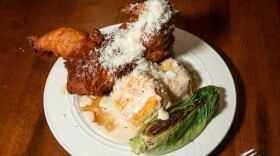Worried about meat supplies, we join the growing ranks of quarantine-minted vegans
Ditching meat wasn’t in our plans for 2020. Yet now, months after panic purchases drove consumers to hoard toilet paper and stock their freezers with grocery buys, we’ve stopped eating meat. But our pandemic diet wasn’t a typical vegan decision. It’s more about trying to control one aspect of existence while outside our home a virus, news of police brutality against citizens, and other social maladies continue unabated. We are meatless for now. What people online refer to as pandemic vegans because we wouldn’t be otherwise. Pandemic vegans still want animal products, but our coronavirus-related shopping patterns call for simple meals with fresh produce. With the times being what they are, simple is always better.
For my family, it started with the missing chicken. Online grocery shopping is now the default way I obtain groceries. Twice a month, I send an order into the ether, and somewhere, in a manner that only exists in my imagination, a machine similar to Rosie, the maid from The Jetsons, executes the list with military precision. No human interfacing is involved.
Yet order after electronic order got filled minus the chicken, the one animal protein we could afford that everyone would agree to eat. Beef prices were outrageous enough that restaurants were adding a surcharge for it, and we haven’t been able to convince our son to eat pork since reading him Charlotte’s Web. Without chicken, we became accidental vegans.
At first, we panicked. Then we decided to embrace going meatless as the COVID-19 crisis exposed stress points in the U.S food markets. The virus caused temporary closures of numerous meatpacking plants and a slower pace of slaughter at others, which led to tightening supplies of some meat products. For foods that were available on the shelves, the demand was 13 percent higher than that of the same period in 2019, according to the U.S. Census Bureau. Furthermore, consumers saw a rise in food prices. Data from the Bureau of Labor Statistics (BLS) found the food-price index increased 1.5 percent in April, following a 0.3 percent increase in March. Buyers of meats, poultry, and fish saw the index rise sharply, by 4.3 percent.
And these numbers don’t show the vast variation in price changes across different products. Prices of ground beef rose by 4.4 percent, while prices of boneless stew beef fell slightly. That’s why shoppers have had a hard time getting the meat they want, and why stores have put limits on the amount you can get at one time. I recall news reports that told us plenty of meat was warehoused in freezers, but I noticed the difference in our grocery bill and in the missing chicken.
We deliberated on eliminating meat during a family meeting. The children didn’t seem to care — a good thing since they don’t contribute to the household beyond being cute. One thing on which we all agreed was to avoid the mock meats. Our aim instead was to try to be happy creating colorful, nutrient-dense dishes made with vegetables, fruits, grains, legumes, nuts, and seeds. I hoped that providing mealtime consistency without worrying about wildly fluctuating meat supplies would offer a measure of stability in this increasingly unstable world.
Has it worked? It turns out that it can be hard to win over the family, a dinner of beans and rice settling uneasily in their stomachs, while cheesy pepperoni goodness stretches across a pizza on television. My preschooler asks for cereal and milk just as we sit down to a hot bowl of cornmeal porridge cooked in coconut milk and vanilla beans and sweetened with dark brown sugar. A lunch of fried cabbage over rice prompts the pretween to suggest a list of things he could sell if we’re struggling for money. “Mom, I can sell my skateboards, scooter, and baseball gear, and the telescope you got me that I didn’t really want,” he says. Then pleads, “Can we please just get some Popeyes chicken?” So, meal-based stability has proven elusive.
I want my son’s life to return to normal. We all want it. I know my pandemic veganism is my way of adjusting to a new idea of normal. My children’s solecisms are reminders that change, no matter how well-intentioned, is probably not what helps people adjust in difficult periods. Still, no Popeyes yet.








